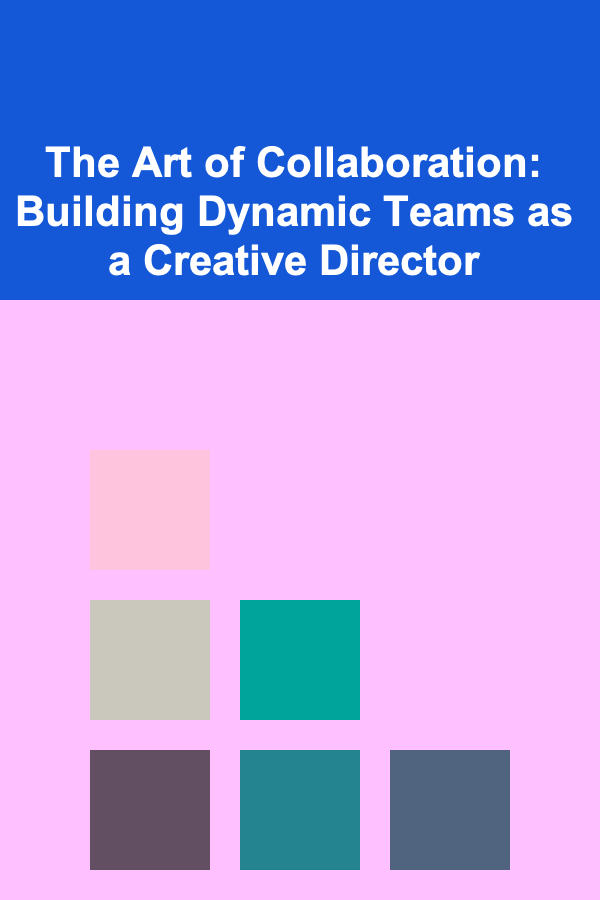
The Art of Collaboration: Building Dynamic Teams as a Creative Director
ebook include PDF & Audio bundle (Micro Guide)
$12.99$8.99
Limited Time Offer! Order within the next:

Collaboration is an essential element in any creative process. As a creative director, your role is not only about crafting visually compelling ideas or overseeing the aesthetics of a project; it's also about fostering a dynamic, collaborative environment where diverse talents, perspectives, and expertise come together to produce the best possible results. Building and leading a successful creative team requires a strategic approach, deep understanding of team dynamics, and a commitment to cultivating a culture of mutual respect and innovation. This article delves into the art of collaboration and offers actionable insights for creative directors to build and manage high-performing teams.
Understand the Role of a Creative Director as a Leader and Facilitator
A creative director's responsibility goes beyond making final design decisions; it's about leading and guiding a group of individuals with varying skill sets towards a common creative vision. You are the bridge between creativity and business, between your team's capabilities and the client's objectives. Effective collaboration starts with your approach to leadership.
Actionable Steps:
- Set Clear Expectations and Objectives: At the outset of any project, ensure that you communicate the overall vision and business goals to your team. While creative freedom is essential, having clear parameters about the objectives allows everyone to stay aligned and motivated.
- Foster Open Communication: Establish an open-door policy and encourage transparency at all levels. Let your team feel comfortable voicing opinions, sharing ideas, or expressing concerns. This helps mitigate misunderstandings and builds trust among team members.
- Be the Enabler, Not the Dictator: While creative direction requires a firm hand, it's essential to facilitate and empower your team. Rather than dictating every decision, provide guidance and room for creative input. Trust your team to take ownership of their areas of expertise.
Assemble the Right Mix of Skills and Personalities
A successful creative team isn't built around just technical skills---it's about creating a balance between different types of creatives. From conceptual thinkers and problem solvers to hands-on designers and writers, a team with diverse skills, backgrounds, and perspectives will generate more innovative and effective solutions. Recognizing each individual's strengths and harnessing them will lead to better creative outcomes.
Actionable Steps:
- Diversify Your Team's Skill Sets: Make sure your team encompasses a broad range of talents. This could mean including graphic designers, writers, illustrators, video producers, UX/UI designers, and strategists. Each role brings a unique perspective and expertise to the table.
- Blend Experience and Fresh Perspectives: Include both seasoned professionals with extensive experience and newer team members who can bring fresh perspectives. A mix of both seasoned wisdom and youthful enthusiasm often sparks innovation.
- Prioritize Complementary Personalities: Personalities matter just as much as skill sets. Look for individuals who not only complement each other's work but can also collaborate effectively. A harmonious blend of introverts, extroverts, independent thinkers, and team players can lead to a more balanced, productive dynamic.
Cultivate a Collaborative Environment
The environment in which your team works plays a pivotal role in fostering creativity and collaboration. A creative space should inspire free thinking, encourage risk-taking, and provide opportunities for cross-pollination of ideas. Whether it's a physical workspace or a virtual one, creating an atmosphere of collaboration can transform the way your team engages with one another and with their work.
Actionable Steps:
- Create a Safe Space for Ideas: Make sure that team members feel confident to share their ideas without fear of judgment. Encouraging a culture where every idea is valued---even the wild or unconventional ones---helps spark innovation.
- Encourage Interdisciplinary Collaboration: Collaboration isn't just about designers working with other designers; it's about breaking down silos between all creative disciplines. Create opportunities for your writers, designers, strategists, and marketers to brainstorm together and share their perspectives.
- Utilize Technology to Enable Seamless Communication: Whether in-person or remote, using the right communication and collaboration tools is crucial. Leverage platforms like Slack, Asana, or Trello for team coordination, and make sure all files and documents are easily accessible via cloud-based tools like Google Drive or Dropbox.
Establish Clear Processes and Milestones
A successful collaboration doesn't mean a chaotic free-for-all. While creative freedom is important, having structure and processes in place ensures that projects stay on track, deadlines are met, and quality is maintained. As a creative director, it's essential to provide clear direction while allowing room for creative exploration.
Actionable Steps:
- Define a Clear Workflow: Establish an organized workflow for each project. Identify key stages of the creative process, including ideation, feedback loops, revisions, and final execution. This keeps everyone aligned and accountable.
- Set Milestones and Deadlines: Break large projects into smaller tasks with specific milestones. Make sure that each phase of the project has a deadline, ensuring that the team remains focused and progress can be measured.
- Communicate Regularly: Schedule regular check-ins or meetings to monitor progress, share feedback, and resolve any issues before they escalate. This helps maintain momentum and ensures that any roadblocks are addressed early on.
Foster a Culture of Feedback and Growth
For collaboration to thrive, feedback must be viewed as an opportunity for growth, not as criticism. Creating an environment where constructive feedback is given and received positively is essential for any creative team. It helps individuals improve their craft, enhances team dynamics, and leads to better overall results.
Actionable Steps:
- Provide Regular Constructive Feedback: Don't wait for the final review to offer feedback. Give ongoing, constructive critiques that help guide the creative process. Be specific about what's working and where improvements can be made.
- Encourage Peer-to-Peer Feedback: Empower team members to give and receive feedback from one another. This creates a more supportive, collaborative atmosphere and allows everyone to learn from their peers.
- Celebrate Successes and Learn from Failures: Recognize achievements and milestones, whether big or small, to keep morale high. Similarly, when things don't go as planned, analyze the situation as a team and focus on learning and improving for the future.
Lead by Example: Demonstrate Collaboration in Your Own Work
As a creative director, your actions set the tone for the entire team. If you want your team to collaborate effectively, you must be willing to demonstrate collaboration yourself. Show that you value input from all team members and that you're open to new ideas and approaches. Leading by example fosters a culture of mutual respect and trust.
Actionable Steps:
- Share Your Creative Process: Let your team in on your thought process and the decisions you make. By demonstrating your own creative journey, you set an example for others to follow.
- Collaborate with Other Teams: Don't isolate yourself within your creative team. Collaborate with other departments, such as marketing, sales, and product development. This strengthens cross-functional relationships and reinforces the importance of collaboration across the organization.
- Stay Open to Constructive Criticism: As a leader, be open to feedback from your team. This shows humility and encourages your team members to feel comfortable challenging ideas and offering suggestions.
Keep the Momentum Going: Nurture Creativity Beyond the Project
Collaboration doesn't stop at the project's conclusion. To build a truly dynamic team, creative directors must work to maintain energy and engagement beyond individual projects. Keeping the creative momentum alive is key to fostering a long-term, productive team culture.
Actionable Steps:
- Create Opportunities for Continuous Learning: Encourage ongoing professional development by providing access to workshops, online courses, or creative conferences. This ensures your team stays up to date with new trends, tools, and techniques.
- Celebrate Team Wins: Regularly celebrate team achievements, both big and small. Whether it's a successful campaign or just a well-executed brainstorming session, celebrating successes reinforces the value of teamwork.
- Organize Creative Retreats or Brainstorming Sessions: Take your team out of the usual work environment to refresh and recharge their creative juices. Whether it's a physical retreat or a dedicated brainstorming session, these experiences can re-energize the team and lead to new creative breakthroughs.
Conclusion
Building a dynamic, collaborative team is both an art and a science. As a creative director, you have the unique opportunity to cultivate an environment where creativity flourishes and innovation thrives. By understanding your role as both a leader and a facilitator, assembling a diverse team of experts, and nurturing a culture of openness, feedback, and growth, you can unlock the full potential of your team. In the world of creativity, the best results are rarely achieved by one person working alone---they're the product of collaboration, where every voice is heard, and every idea has the chance to grow.
Fostering collaboration isn't a one-time effort; it's a continuous process of listening, leading, and evolving. The more you invest in building strong, collaborative relationships within your team, the more creative breakthroughs and successes you'll achieve together.

How to Clean and Maintain Your Refrigerator
Read More
How to Clean Your Electric Kettle for Better Performance
Read More
How to Get Your Partner on Board with Your Financial Plan
Read More
How to Update Your Home's Exterior Without Spending Too Much
Read More
How to Develop Your Own AI Assistant
Read More
How To Build a Strong Team Identity
Read MoreOther Products

How to Clean and Maintain Your Refrigerator
Read More
How to Clean Your Electric Kettle for Better Performance
Read More
How to Get Your Partner on Board with Your Financial Plan
Read More
How to Update Your Home's Exterior Without Spending Too Much
Read More
How to Develop Your Own AI Assistant
Read More